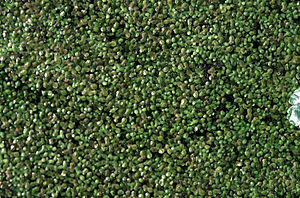Petite duckweed
| Petite duckweed | ||||||||||||
|---|---|---|---|---|---|---|---|---|---|---|---|---|

Dainty duckweed ( Lemna minuta ) |
||||||||||||
| Systematics | ||||||||||||
|
||||||||||||
| Scientific name | ||||||||||||
| Lemna minuta | ||||||||||||
| L. |
The petite duckweed ( Lemna minuta ) is the smallest species of the plant genus duckweed ( Lemna ) within the family of the arum family (Araceae). The original distribution area is unclear; it is a neophyte in many parts of the world , for example in Germany .
description
Vegetative characteristics
Lemna minuta is a tiny herbaceous plant . It varies in shape depending on the growing conditions. In the shade, the shape is limited to a single green, translucent, oval leaf no more than 2.5 millimeters long. In full sunlight it usually grows with symmetrical pairs of leaves. There is a ridge along the center line that makes the duckweed appear roof-shaped. Lemna forms a central root with a length of 0.2 to 1.5 centimeters.
Scion limbs: 0.8 to a maximum of 4 millimeters long, once or twice as long as wide.
Generative characteristics
Lemna minuta rarely produces an inflorescence in Central Europe , but if this is the case, the flowering period extends from May to September.
Male flowers: 2, microscopic, each with only one stamen, sepals and petals missing
Female flower: 1, microscopic, sepals and petals missing, style: 1
♂ * P0 A1 G0
♀ * P0 A0 G1
The solitary, achenaic fruit has 12 to 15 longitudinal ribs. The seed is 0.6 to 1 millimeter in size.
ecology
The pollination occurs in Central Europe by water spiders and water striders .
distribution
Lemna minuta is native to parts of America and naturalized in Japan and Europe; the exact native range is not known. The spread of Lemna minuta is constantly increasing; it has spread throughout Europe and was first described in Germany in 1973. In many areas it is an " invasive plant species ", such as in Belgium.
Locational conditions in Central Europe

The petite duckweed grows in slow moving, calm and standing freshwater habitats (ponds, pools, small lakes, slow flowing waters). It influences the ecology of its populated habitat by mass-producing mats on the surface of the water that reduce the penetration of sunlight and the exchange of oxygen.
Individual evidence
- ↑ a b Petite duckweed . In: BiolFlor, the database of biological-ecological characteristics of the flora of Germany.
- ↑ a b Flora Emslandia, Lemna minuta, Zierliche Wasserlinse. Retrieved July 12, 2019 .
- ^ A b Invasive Alien Species in Belgium: Lemna minuta. Retrieved July 12, 2019 .